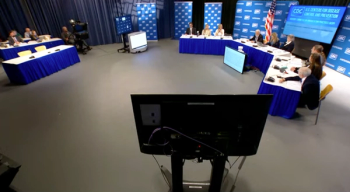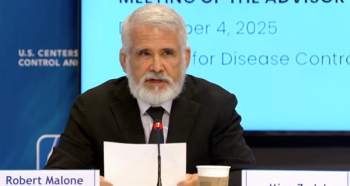Loud and clear warnings forecasting the current shortage of primary care physicians in the United States date back to the early 2000s.
Related: Here is the PCP crisis solution and it's simple
Of almost 12,000 primary care physicians responding to a 2008 Physicians Foundation Survey, about half stated they would consider leaving medicine.
A CNN report summarizing the findings stated that “many [primary care physicians] said they are overwhelmed with their practices, not because they have too many patients, but because there’s too much red tape generated from insurance companies and government agencies.”
In response, one would have expected that policymakers, when assessing the merits of a proposed healthcare initiative or regulation, would weigh the measure’s likely impact on making primary care practice less burdensome. Yet, such consideration was apparently given little weight when the Health Information Technology for Clinical Health (HITECH) Act was passed as part of the 2009 American Recovery and Reinvestment Act. HITECH broadened the authority of the Centers for Medicare & Medicaid Services (CMS) to utilize pay-for-performance (P4P) programs as a means of physician compensation. Needless to say, HITECH’s passage struck a major blow to physician autonomy.
Further reading: How physicians can deal with uncertainty
In a 2009 interview, President Obama acknowledged the PCP shortage and the difficulty in attracting physicians to choose a career in primary care, stating: “…keep in mind that the status quo is we don’t have enough primary care physicians. We’ve got to create more primary care physicians. And what we want to do is to provide a powerful set of incentives for more and more young people who are interested in healthcare … to go into primary care.” But the situation only worsened with the birth of the Medicare Annual Wellness Visit (AWV), courtesy of the Affordable Care Act.
As I outlined in Medical Economics last year, the AWV is a burdensome, inflexible Electronic Health Record (EHR) box-checking encounter scripted by CMS, with a weak evidence base and a one-size -fits all approach.Thus, the net result of HITECH’s enactment in 2009 followed by the passage of Obamacare the following year, was a further erosion of PCP autonomy and a further reduction in primary care’s appeal.
Which makes the expansion of P4P through the enactment of the Medicare Access and CHIP Reauthorization Act of 2015 (MACRA) even more disheartening. That MACRA was passed by an overwhelming majority in both houses of Congress underscores what little interest policymakers have in attracting more physicians into the field of primary care.
For the PCPs, CMS’s embrace of P4P didn’t just limit autonomy, it replaced autonomy with compromise and conflict of interest. Some examples of the conflict: Does the physician engage female patients in a discussion of the pros and cons of mammography screening and risk falling short of the threshold percentage required for CMS “reward” revenue? Or does one simply go along with CMS guidelines, limiting mention of evidence raising doubts about the benefits of this screening measure?
Next: Support doesn't seem likely
How about pursuing tight glycemic control in patients with Type 2 DM, despite evidence suggesting a lack of benefit? Does the PCP present the patient with low back pain with the latest evidence regarding efficacy of various interventions-perhaps sharing some journal articles on the subject-or does he or she instead hand the patient a simplistic, non-evidence based “low back pain” handout generated from CMS-approved patient education software, as incentivized by MU? For that matter, should one spend limited visit time discussing important studies regarding interventions that CMS has not included in its P4P measures?
Related: Strategies for making PCP practices more efficient
For years after the publication of evidence outlining the benefit of one-time screening for abdominal aortic aneurysm in men over age 65 who had ever smoked, CMS did not make screening of this population one of its P4P measures. One could cite many other examples. Unfortunately, the practice of primary care under such steady ethical conflict has become the norm.
A 2016 American Association of Medical College (AAMC) report predicted that there will be a national PCP shortage numbering anywhere from 12,500 to 31,100 by 2025. A Physicians Foundation survey of over 17,000 physicians released a few months later identified low physician morale as the primary factor underlying the worsening shortage.The survey found that “physicians identify regulatory/paperwork burdens and loss of clinical autonomy” as their primary sources of dissatisfaction. Physicians Foundation President Walker Ray commented that “by retiring, taking non-clinical roles or cutting back in various other ways, physicians are essentially voting with their feet and leaving the clinical workforce.
“This trend is to the detriment of patient access. It is imperative that all healthcare stakeholders recognize and begin to address these issues more proactively, to support physicians and enhance the medical practice environment.”
Given the decisions of policymakers in response to similar warnings over the past decade, such support does not seem likely.
Hawkins, Merritt. "The physicians' perspective: medical practice in 2008." Boston, MA: The Physicians Foundation (2008).
http://www.cnn.com/2008/HEALTH/11/17/primary.care.doctors.study/
ABC’s “World News With Diane Sawyer (http://abcnews.go.com/Politics/story?id=8091227&page=2#.UBVGzWGe4rU),”7/15/09
http://medicaleconomics.modernmedicine.com/medical-economics/news/cms-incentivizes-unnecessary-medicare-wellness-visits
Miller Anthony B, Wall Claus, Baines Cornelia J, Sun Ping, To Teresa, Narod Steven A et al. Twenty five year follow-up for breast cancer incidence and mortality of the Canadian National Breast Screening Study: randomised screening trial BMJ 2014; 348 :g366
Gerstein HC, et al. "Effects of Intensive Glucose Lowering in Type 2 Diabetes". The New England Journal of Medicine. 2008. 358(24):2545-59.
Hemmingsen Bianca, Lund Søren S, Gluud Christian, Vaag Allan, Almdal Thomas, Hemmingsen Christina et al. Intensive glycaemic control for patients with type 2 diabetes: systematic review with meta-analysis and trial sequential analysis of randomised clinical trials BMJ 2011; 343 :d6898
Guirguis-Blake, Janelle M., et al. "Ultrasonography screening for abdominal aortic aneurysms: a systematic evidence review for the US Preventive Services Task Force." Annals of internal medicine 160.5 (2014): 321-329.
https://www.heartland.org/_template-assets/documents/publications/2016_complexities_of_supply_and_demand_projections.pdf
www.physiciansfoundation.org/news/the-physcians-foundation-2016-physician-survey/
www.businesswire.com/news/home/20160921005410/en/Survey-17000-Physicians-Finds-Shifting-Practice-Patterns
















